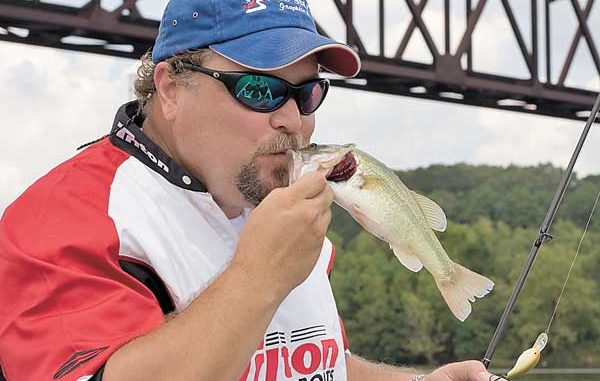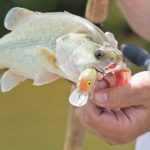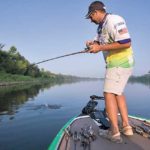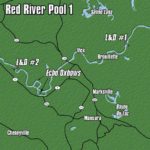
Pools 1 and 2 of the Red River are starting to really deliver the goods, outshining their better-known counterparts.
Perhaps Rodney Dangerfield didn’t get any respect because he acted in a way that wasn’t deserving of respect. As most anybody in a leadership position will tell you, respect has to be earned rather than demanded. It is surprising, then, that pools 1 and 2 on the Red River still don’t get much respect. They’ve done enough to earn it — they just haven’t gotten it. Perhaps pools 1 and 2 get disrespected because they are the strong, silent type.
There isn’t any brazen breast-beating going on around Alexandria, and even though these two pools have done more than enough to attract the attention of the Louisiana largemouth community, they continue to get pushed aside in favor of pools 3, 4 and 5.
No respect, I tell you … no respect.
“The big secret down here is that there are just as many quality largemouth bass in pools 1 and 2 as there are in 3, 4 and 5,” said BASS Weekend Series angler Jason Bordelon of Pineville. “I think that’s why a lot of anglers tend to shy away from the lower pools. You’ve got to fish a little bit differently to catch them, but the big fish are here.”
If you didn’t even know there was a Red River pool 1 and pool 2, much less that they provide excellent bass fishing, you probably aren’t alone.
According to Porter Trimble, host of the Southern Woods & Water TV show seen in Central and North Louisiana, most folks haven’t heard about these lower pools because pools 4 and 5 have been the most publicized since the completion of the lock-and-dam project.
“Everybody wanted to go up there because of seemingly endless supplies of big bass,” said Trimble. “All the big tournaments were held up there, and that’s what people read about. However, the river has kind of settled down the last couple of years, and now it seems like that same kind of good fishing is steadily moving south. In fact, it seems like pool 3 is the No. 1 pool on the entire chain at the moment.”
Pools 1 and 2 also aren’t very appealing to the eyes. Rather than sprawling backwaters full of lush, green hydrilla and ragged, weathered timber, pools 1 and 2 are full of … well, they aren’t full of much of anything of all. And there’s the rub.
Bass anglers love to fish things they can see, and according to Trimble, except for the rocks in the main river, they aren’t going to see most of the spots that hold bass down here. While the Red River becomes more river-like and less lake-like as it flows south toward the Atchafalaya River near the Old River control structure, it actually fishes more like a lake down here than a river in at least one particular example.
“The thing about fishing down here, at least in Pool 2, is that you don’t need what most would consider traditional cover and structure to attract bass,” said Trimble. “Because there isn’t much cover that anglers can see, they assume there aren’t any bass. Like fishing deep structure in a lake, just remember that you don’t have to see the cover for it to be there and hold bass.”
What kind of cover is there underwater that would attract and hold bass? Trimble pointed out that many of these backwaters weren’t as expansive before the lock-and-dam project as they are now. As the water backed up behind each lock, it covered up many small channels, ditches, ridges and humps, and these are the kinds of things that hold bass now in the backwater lakes.
“These things are now like miniature versions of the creek channels and humps you might find in a big lake like Toledo Bend or D’Arbonne,” Trimble said. “Only out here in these two pools, the differences in depth will be a lot more subtle.
“You may be fishing in 6 feet of water and run across an area where it drops down into 8 feet. That 2-foot difference may not seem like much to you as an angler, but to the bass in pools 1 and 2, it makes all the difference in the world.”
Bordelon agrees that the lack of visible cover in the backwaters around Alexandria makes the ability to find subtle changes with your electronics extremely important. In fact, he recommended that visiting anglers who aren’t familiar with pools 1 and 2 spend at least a few hours graphing any backwater they elect to fish.
“Since you don’t have all the visible stumps and stick-ups that the northern pools have, you’ll have to spend some time searching for brushpiles,” said Bordelon. “There are quite a few piles that anglers have put out over the years, and the lack of other cover makes these man-made piles extremely inviting to bass.”
These unappealing backwater lakes are exactly where Bordelon and Trimble begin any fall fishing trip during October. Like many other Louisiana fisheries this time of year, the key to finding the most productive backwaters is to look for those with obvious signs of baitfish activity.
“Anywhere you see shad flipping around is a good place to start,” Bordelon said. “One of the key things that I look for is shad that follow my spinnerbait or crankbait. If I see four or five of them following my lure beside the boat, I know I’m in the right spot.”
As for which of the backwaters in pools 1 and 2 are the best, Bordelon said it is difficult to precisely pinpoint just one or two because they can all turn on at one time or another during October. Therefore, saying that one is any better than the others would be a stretch at best.
“About the only thing I can say about that is that the bass have been kind of crazy so far this year,” Bordelon added. “The fish have kind of stayed in deeper water, and I expect the deeper oxbows are going to be the most productive this fall. In pool 2, I would definitely give Palmer Chapel, the Pineville Oxbow and Bayou Ramsey a good look. In pool 1, I would concentrate on the Echo oxbow this fall.”
Bordelon concentrates on working the 3- to 5-foot depths in the backwaters this time of year because he believes most of the bass will pull up that shallow to gorge on the balled-up shad. While there may still be some big bass in the 15-foot-deep brushpiles, the shallower fish tend to be more aggressive and easier to catch.
Given his druthers, Bordelon says he would make sure to tie on three different lures for fall fishing in pools 1 and 2 — a shad-colored Bandit crankbait, a mouse- or blue herring-colored War Eagle spinnerbait and a black/blue or watermelon jig.
“You should remember, though, that this water has had all summer long to clear up,” Bordelon said. “I think it’s really important to use some kind of line that is harder for the fish to see. Fluorocarbon is good for that, but I’m really big on the green Hi-Seas Grand Slam line.
“I come from a family of commercial fishermen, and I know that commercial mono nets are green because it disappears in the water — that’s important for these shallow oxbow fish in this cleaner water. There are a lot of good lines in different colors out there today, but I wouldn’t ever shy away from the green line.”
While many may equate October fishing with topwater lures, Bordelon says that isn’t necessarily the case on pools 1 and 2. He keeps a Chug Bug or buzz bait tied on to check the surface bite, but he typically begins his morning with lures that most people wouldn’t pick up until the sun topped the trees.
“You have to fish a little deeper down here than you do in 3, 4 and 5,” he said. “There is tons of topwater action up north, but here I tend to start off with my crankbaits and spinnerbaits rather than a frog or buzz bait.”
Trimble seconded Bordelon’s backwater selection, but he added a tip of his own. One of the things he does when moving from the river to a backwater lake is to increase the size of his lures, especially a plastic worm.
“Out on the river, it’s hard to beat a small, 7-inch ribbontail worm,” Trimble said. “But when I move into an oxbow, I go up to an 11-inch worm. The fish in the backwaters tend to be the bigger largemouths, whereas out on the river, there are a lot of smaller bass and all those spotted bass — bigger bait in the oxbows, bigger bass on the line.”
While both anglers make sure to check the bite in the oxbow lakes, they both also say that the main river fishing can be excellent during October, especially for the big spotted bass. The main river has always held some excellent spotted bass fishing, but Trimble says the size of the spots has really increased the last couple of years.
“There have been some 3 1/4- to 3 1/2-pound spots showing up in pools 1 and 2,” Trimble said. “Both pools have great spot fishing, but it seems like the crankbait bite down in pool 1 is unreal during October. Like the backwaters, it’s hard to say which stretch of rocks will hold the spots, so you just have to fish around until you find the shad — you can bet the spots will be nearby.”
If there is any secret to finding the spotted bass in the main river, it is to look for what Trimble called transition rocks. These are the places in the rocks where something changes. One commonly found transition is a section along a jetty or revetment where the size of the rocks increases from small rocks to boulder-sized rocks.
Like fishing the acres and acres of grass in Toledo Bend, anglers who stay on the rocks can fish a mile without so much as a bite, and then they’ll catch five or six fish in a 50-yard stretch.
“You can bet there is something different about that stretch,” Trimble said. “It might not be anything you can see above the surface, but there’s something different underwater. Maybe there are some boulders that fell down from the exposed rocks. Maybe the bottom changed from mud to sand. It doesn’t really matter what the change is as long as there is a change.”
One thing that main-river anglers should pay attention to is the presence of current. Whether it is wind-driven or a result of the locks opening and closing, any kind of water movement can turn on the spotted bass bite in a hurry. Trimble explained that current typically flows faster near the locks, so some of the best spotted-bass fishing is found near these structures.
While the spots are likely to eat just about anything that comes across their faces, Trimble says Shakey Head worms are really hard to beat, as are 200-series Bandit crankbaits and small spinnerbaits.
“The Shakey Head is just a little bit more of a finesse presentation, which appeals to the spotted bass,” he said. “It’s just like fishing a Texas-rigged worm, but the action is a little more erratic, and I think that attracts the spots. Have a good supply of the heads, though, because the smaller weights tend to fall down into the cracks around the rocks, and you’re going to wind up breaking them off.”
Anglers who spend a lot of time on the rocks also know it’s hard to beat that 200-series crankbait. Whether it’s just the right size, has the right wiggle or dives the right depth, it’s just hard to beat.
It’s not just a chunk-and-wind affair, though, and spending a little time tweaking your bait will pay off with more bites.
“You’ve got to make your crankbait bump the rocks,” Trimble said. “If you don’t feel your crankbait hitting something, you need to move closer until you do. A lot of anglers who stay in the main river tune their crankbaits to make them run either right or left so their crankbaits actually bang into the rocks throughout an entire retrieve.”
As Trimble and Bordelon have pointed out, it really doesn’t matter if you’re banging the rocks in the river or pulling a crankbait in the oxbows, pools 1 and 2 of the Red River deserve respect because they have earned it.
Pools 1 and 2 may not try to attract your attention, but they should get your attention. Like one that leads by example, pools 1 and 2 let their actions speak for themselves. They don’t really care if you notice or not.








